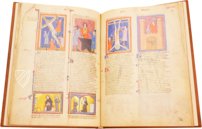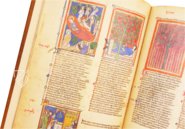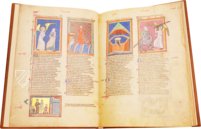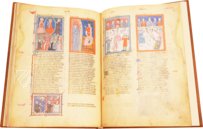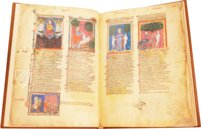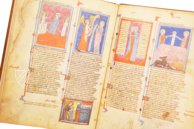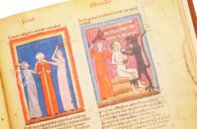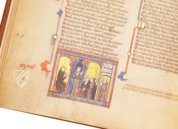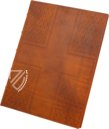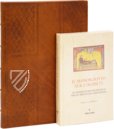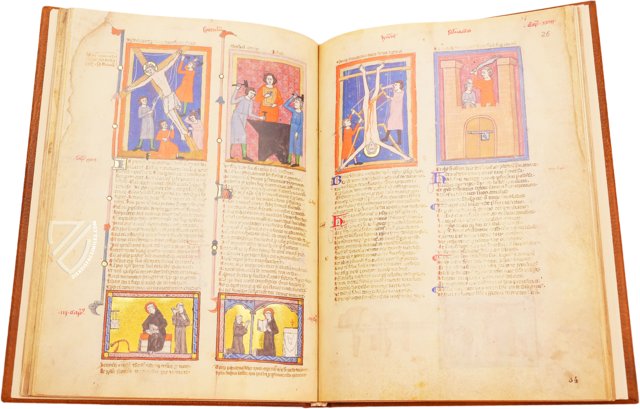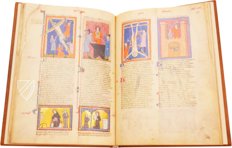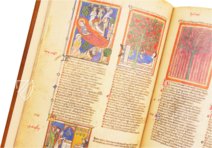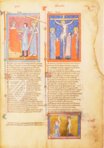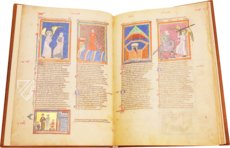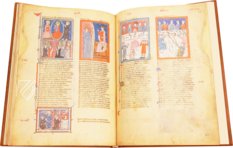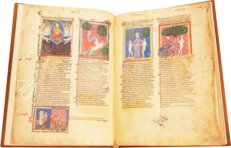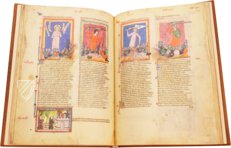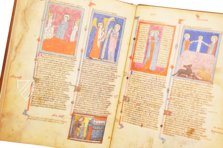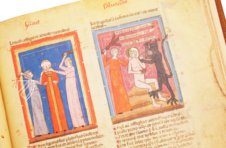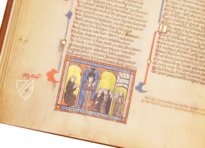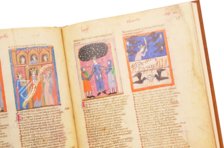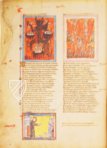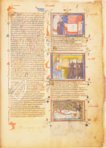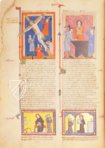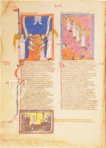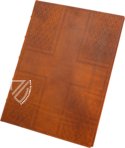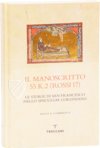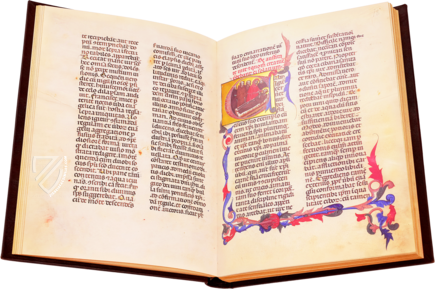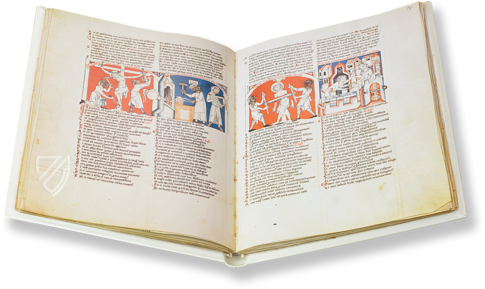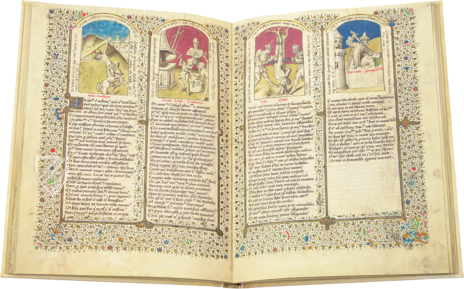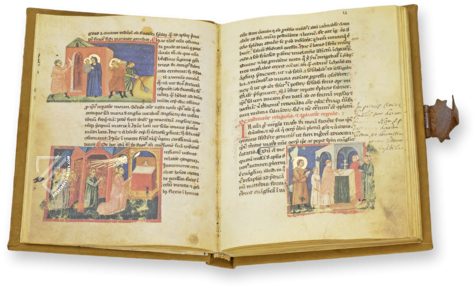Corsiniana Mirror of Human Salvation
(3,000€ - 7,000€)
In this unique Mirror of Human Salvation, which was created in Avignon around 1340 by four book artists, the Christian salvation story is linked to the life of St. Francis of Assisi (1181/82–1226). The Italian saint and founder of the order of the Franciscans, who lived according to the ideal of Jesus, is portrayed as a follower of Christ in 49 gold-decorated miniatures, in which scenes from his life are set in analogy to depictions from the life of Jesus. This is absolutely extraordinary among the many surviving copies of the Speculum humanae salvationis, which was a bestseller of the Middle Ages and explains the divine plan of salvation for laypeople. This is illustrated in a further 178 column-wide miniatures that visualize stories from the Old and New Testaments. Executed in the French Gothic style, they stand out in bright colors and gleaming gold leaf. The remarkable, decidedly Franciscan decoration of the manuscript makes it one of the most interesting and at the same time most artistic copies of the Speculum humanae salvationis.
Corsiniana Mirror of Human Salvation
The Speculum humanae salvationis (Mirror of Human Salvation) was one of the most widespread salvation books of the late Middle Ages. It was used especially by laypeople to comprehend the Christian salvation story and to understand the connections between the Old and New Testaments. As a typological work, the Mirror of Salvation pointed out so-called prefigurations: each New Testament story ('antitype') was juxtaposed with three 'types' of the Old Testament, whose analogies were intended to testify that the arrival of the Messiah Jesus Christ was predestined and was already foreshadowed in the actually Jewish writings of the Bible. From this, the all-encompassing salvation plan of God was assumed.
The Salvation Story for the Laity
The Latin Mirror of Salvation from the Biblioteca Corsiniana in Rome contains the common version of the text, which was probably originally written in Italy at the beginning of the 14th century. It begins with an introductory chapter on the creation of the world, summarizing the Book of Genesis, followed by the main chronological section on the Lives of Jesus and Mary. The last three chapters include devotions on the Seven Stations of the Cross, the Seven Sorrows and the Seven Joys of Mary.
Typological Layout
This content is spread over four columns of text on each double page, so that each antitype (left) can be shown in the main section with its corresponding Old Testament types. Each text column begins with a column-wide miniature depicting the respective biblical event in bold colors and wide frames, with red and blue shades dominating the color palette. At the beginning and end of the manuscript there are also several Genesis miniatures and further images of the life of Christ and from the life of Mary, corresponding to the texts.
A Franciscan Mirror of Salvation
The unique special feature of this high-quality manuscript are the 49 framed bas-de-page miniatures, which can be found at the foot of each of the text columns for the antitypes. They show scenes from the life of St. Francis of Assisi, which are directly associated with Jesus through this remarkable positioning. In the spirit of the Imitatio Christi, Francis is presented here as a follower of Christ who committed his life to the ideal of Jesus. Each picture emphasizes a parallel between the life of the saint and the events of the New Testament.
A Collective Work
This unique and precious decoration of the manuscript was probably the work of one scribe and three illuminators. While the major part of the illumination can be attributed to an artist named Guillaume, the miniatures of St. Francis were executed by an unknown master who was particularly generous in his use of gold leaf. The secondary illumination in the form of initials and borders was probably executed by an anonymous Italian illuminator. Although the manuscript has some flaws, its special composition makes it one of the most interesting and at the same time most artistic examples of the Speculum humanae salvationis.
Codicology
- Alternative Titles
- Storie di San Francesco
Heilsspiegel mit Bildern aus dem Leben des Heiligen Franziskus
Stories of Saint Francis in the Corsinian Speculum - Size / Format
- 94 pages / 32.5 × 23.0 cm
- Origin
- France
- Date
- Mid 14th century
- Epochs
- Style
- Genre
- Language
- Illustrations
- 277 miniatures
- Content
- Speculum humanae salvationis and picture cycles with scenes from the Bible and the life of St. Francis
Corsiniana Mirror of Human Salvation
St. Francis Banishes a Demon
Strife and discord reign in Arezzo - even among Francis' brethren. They are afflicted by demons called violence and hatred. Francis instructs a fellow brother to banish the devil in the name of God. The latter turns from the left side of the scene with a gesture of speech to the friar in the center, who is possessed by a winged demon. Meanwhile, on the right, St. Francis, recognizable by his stigmatized hands, prays to God, whose mercy finally drives the demons out of Arezzo. The differentiated architectural framing emphasizes that the saint is acting as an outsider as he is not a direct part of the town's community and has therefore not been afflicted by the devil himself.
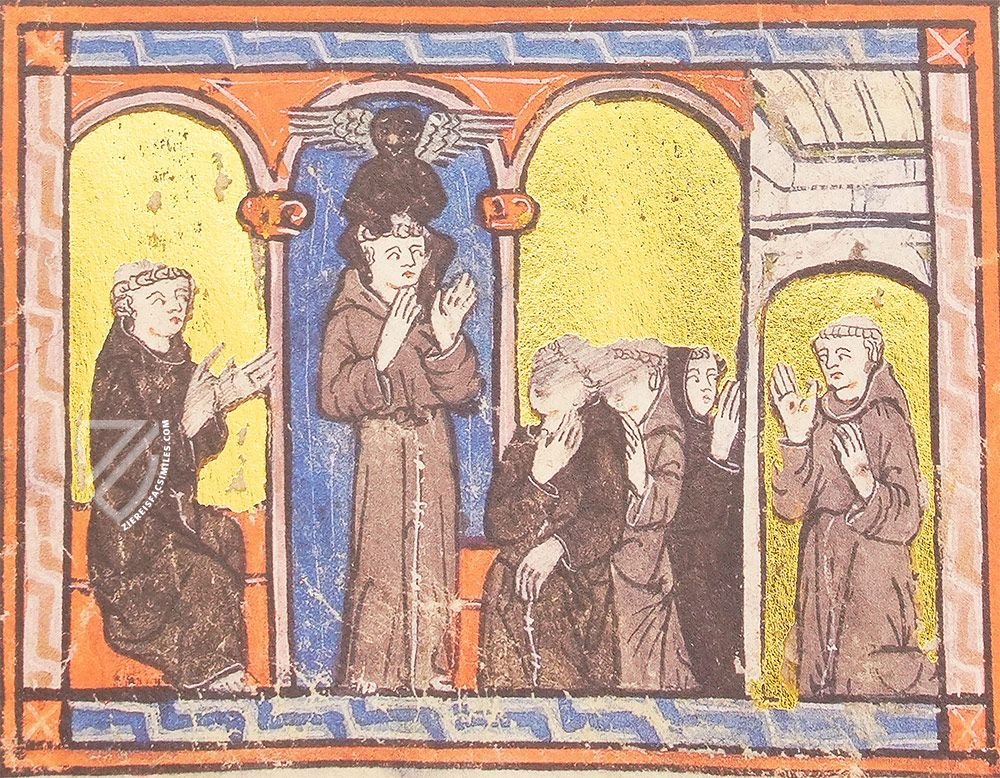
Corsiniana Mirror of Human Salvation
Christ's Ascension and Jacob's Ladder
The page opens with an image of the Ascension. Flanked by two angels, eight disciples kneel at the Mount of Olives and worship their Lord ascending into heaven (Acts 1, 9; Luke 24, 51). Only Christ's feet with the stigmata of the crucifixion can be seen at the upper edge of the picture; the frame serves as a threshold between heaven and the earthly sphere. The angels are also border crossers of this threshold, as their golden wings extend far beyond the frame. Christ's footprints remain on the summit of the Mount of Olives as evidence of the temporary appearance of the Resurrected on earth.
In the Old Testament scene accompanying the Ascension, we also see angels moving between heaven and earth. They go up and down the heavenly ladder in Jacob's vision (Gen 28:11). As the gateway to heaven, Jacob's ladder prefigures the Ascension of Christ.
In the bas-de-page, an analogy is drawn between the Ascension and St. Francis' approaching death. Afflicted by illness, the saint knows that he will soon die. Surrounded by his brothers, to whom he bids a loving farewell and with whom he says one last prayer, he looks forward to his upcoming demise with confidence. The kingdom of heaven is already beginning to open up to him.
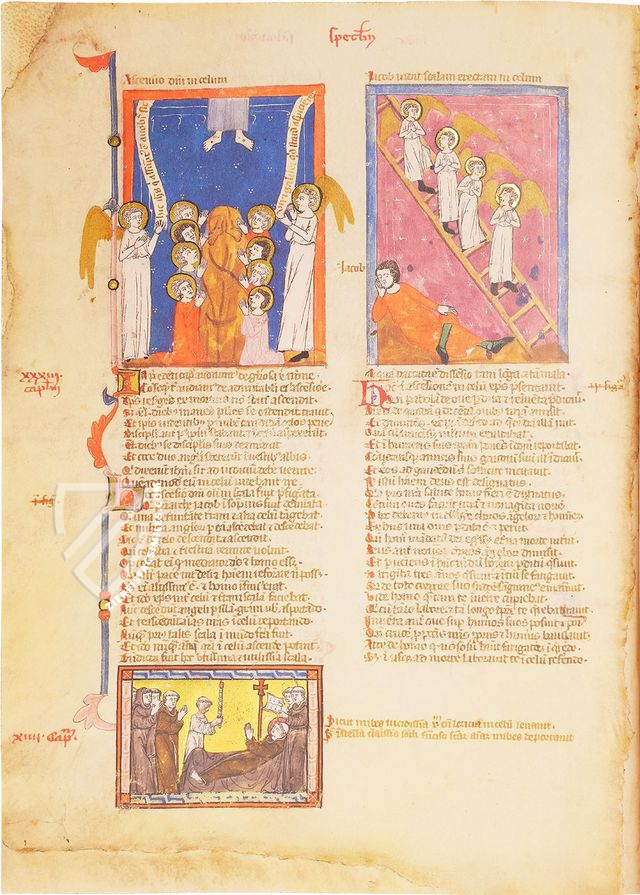
#1 Storie di San Francesco
Language: Italian
(3,000€ - 7,000€)
- Treatises / Secular Books
- Apocalypses / Beatus
- Astronomy / Astrology
- Bestiaries
- Bibles / Gospels
- Chronicles / History / Law
- Geography / Maps
- Saints' Lives
- Islam / Oriental
- Judaism / Hebrew
- Single Leaf Collections
- Leonardo da Vinci
- Literature / Poetry
- Liturgical Manuscripts
- Medicine / Botany / Alchemy
- Music
- Mythology / Prophecies
- Psalters
- Other Religious Books
- Games / Hunting
- Private Devotion Books
- Other Genres
- Afghanistan
- Armenia
- Austria
- Belgium
- Belize
- Bosnia and Herzegovina
- China
- Colombia
- Costa Rica
- Croatia
- Cyprus
- Czech Republic
- Denmark
- Egypt
- El Salvador
- Ethiopia
- France
- Germany
- Greece
- Guatemala
- Honduras
- Hungary
- India
- Iran
- Iraq
- Israel
- Italy
- Japan
- Jordan
- Kazakhstan
- Kyrgyzstan
- Lebanon
- Liechtenstein
- Luxembourg
- Mexico
- Morocco
- Netherlands
- Palestine
- Panama
- Peru
- Poland
- Portugal
- Romania
- Russia
- Serbia
- Spain
- Sri Lanka
- Sweden
- Switzerland
- Syria
- Tajikistan
- Turkey
- Turkmenistan
- Ukraine
- United Kingdom
- United States
- Uzbekistan
- Vatican City
- A. Oosthoek, van Holkema & Warendorf
- Aboca Museum
- Ajuntament de Valencia
- Akademie Verlag
- Akademische Druck- u. Verlagsanstalt (ADEVA)
- Aldo Ausilio Editore - Bottega d’Erasmo
- Alecto Historical Editions
- Alkuin Verlag
- Almqvist & Wiksell
- Amilcare Pizzi
- Andreas & Andreas Verlagsbuchhandlung
- Archa 90
- Archiv Verlag
- Archivi Edizioni
- Arnold Verlag
- ARS
- Ars Magna
- ArtCodex
- AyN Ediciones
- Azimuth Editions
- Badenia Verlag
- Bärenreiter-Verlag
- Belser Verlag
- Belser Verlag / WK Wertkontor
- Benziger Verlag
- Bernardinum Wydawnictwo
- BiblioGemma
- Biblioteca Apostolica Vaticana (Vaticanstadt, Vaticanstadt)
- Bibliotheca Palatina Faksimile Verlag
- Bibliotheca Rara
- Boydell & Brewer
- Bramante Edizioni
- Bredius Genootschap
- Brepols Publishers
- British Library
- C. Weckesser
- Caixa Catalunya
- Canesi
- CAPSA, Ars Scriptoria
- Caratzas Brothers, Publishers
- Carus Verlag
- Casamassima Libri
- Centrum Cartographie Verlag GmbH
- Chavane Verlag
- Christian Brandstätter Verlag
- Circulo Cientifico
- Club Bibliófilo Versol
- Club du Livre
- CM Editores
- Collegium Graphicum
- Collezione Apocrifa Da Vinci
- Comissão Nacional para as Comemorações dos Descobrimentos Portugueses
- Coron Verlag
- Corvina
- CTHS
- D. S. Brewer
- Damon
- De Agostini/UTET
- De Nederlandsche Boekhandel
- De Schutter
- Deuschle & Stemmle
- Deutscher Verlag für Kunstwissenschaft
- DIAMM
- Droz
- E. Schreiber Graphische Kunstanstalten
- Ediciones Boreal
- Ediciones Grial
- Ediclube
- Edições Inapa
- Edilan
- Editalia
- Edition Deuschle
- Edition Georg Popp
- Edition Leipzig
- Edition Libri Illustri
- Editiones Reales Sitios S. L.
- Éditions de l'Oiseau Lyre
- Editions Medicina Rara
- Editorial Casariego
- Editorial Mintzoa
- Editrice Antenore
- Editrice Velar
- Edizioni Edison
- Egeria, S.L.
- Eikon Editores
- Electa
- Emery Walker Limited
- Enciclopèdia Catalana
- Eos-Verlag
- Ephesus Publishing
- Ernst Battenberg
- Eugrammia Press
- Extraordinary Editions
- Fackelverlag
- Facsimila Art & Edition
- Facsimile Editions Ltd.
- Facsimilia Art & Edition Ebert KG
- Faksimile Verlag
- Feuermann Verlag
- Folger Shakespeare Library
- Franco Cosimo Panini Editore
- Friedrich Wittig Verlag
- Fundación Hullera Vasco-Leonesa
- G. Braziller
- Gabriele Mazzotta Editore
- Gebr. Mann Verlag
- Gesellschaft für graphische Industrie
- Getty Research Institute
- Giovanni Domenico de Rossi
- Giunti Editore
- Graffiti
- Grafica European Center of Fine Arts
- Guido Pressler
- Guillermo Blazquez
- Gustav Kiepenheuer
- H. N. Abrams
- Harrassowitz
- Harvard University Press
- Helikon
- Hendrickson Publishers
- Henning Oppermann
- Herder Verlag
- Hes & De Graaf Publishers
- Hoepli
- Holbein-Verlag
- Houghton Library
- Hugo Schmidt Verlag
- Idion Verlag
- Il Bulino, edizioni d'arte
- ILte
- Imago
- Insel Verlag
- Insel-Verlag Anton Kippenberger
- Instituto de Estudios Altoaragoneses
- Instituto Nacional de Antropología e Historia
- Introligatornia Budnik Jerzy
- Istituto dell'Enciclopedia Italiana - Treccani
- Istituto Ellenico di Studi Bizantini e Postbizantini
- Istituto Geografico De Agostini
- Istituto Poligrafico e Zecca dello Stato
- Italarte Art Establishments
- Jan Thorbecke Verlag
- Johnson Reprint Corporation
- Josef Stocker
- Josef Stocker-Schmid
- Jugoslavija
- Karl W. Hiersemann
- Kasper Straube
- Kaydeda Ediciones
- Kindler Verlag / Coron Verlag
- Kodansha International Ltd.
- Konrad Kölbl Verlag
- Kurt Wolff Verlag
- La Liberia dello Stato
- La Linea Editrice
- La Meta Editore
- Lambert Schneider
- Landeskreditbank Baden-Württemberg
- Leo S. Olschki
- Les Incunables
- Liber Artis
- Library of Congress
- Libreria Musicale Italiana
- Lichtdruck
- Lito Immagine Editore
- Lumen Artis
- Lund Humphries
- M. Moleiro Editor
- Maison des Sciences de l'homme et de la société de Poitiers
- Manuscriptum
- Martinus Nijhoff
- Maruzen-Yushodo Co. Ltd.
- MASA
- Massada Publishers
- McGraw-Hill
- Metropolitan Museum of Art
- Militos
- Millennium Liber
- Müller & Schindler
- Nahar - Stavit
- Nahar and Steimatzky
- National Library of Wales
- Neri Pozza
- Nova Charta
- Oceanum Verlag
- Odeon
- Orbis Mediaevalis
- Orbis Pictus
- Österreichische Staatsdruckerei
- Oxford University Press
- Pageant Books
- Parzellers Buchverlag
- Patrimonio Ediciones
- Pattloch Verlag
- PIAF
- Pieper Verlag
- Plon-Nourrit et cie
- Poligrafiche Bolis
- Presses Universitaires de Strasbourg
- Prestel Verlag
- Princeton University Press
- Prisma Verlag
- Priuli & Verlucca, editori
- Pro Sport Verlag
- Propyläen Verlag
- Pytheas Books
- Quaternio Verlag Luzern
- Reales Sitios
- Recht-Verlag
- Reichert Verlag
- Reichsdruckerei
- Reprint Verlag
- Riehn & Reusch
- Roberto Vattori Editore
- Rosenkilde and Bagger
- Roxburghe Club
- Salerno Editrice
- Saltellus Press
- Sandoz
- Sarajevo Svjetlost
- Schöck ArtPrint Kft.
- Schulsinger Brothers
- Scolar Press
- Scrinium
- Scripta Maneant
- Scriptorium
- Shazar
- Siloé, arte y bibliofilia
- SISMEL - Edizioni del Galluzzo
- Sociedad Mexicana de Antropología
- Société des Bibliophiles & Iconophiles de Belgique
- Soncin Publishing
- Sorli Ediciones
- Stainer and Bell
- Studer
- Styria Verlag
- Sumptibus Pragopress
- Szegedi Tudomànyegyetem
- Taberna Libraria
- Tarshish Books
- Taschen
- Tempus Libri
- Testimonio Compañía Editorial
- Thames and Hudson
- The Clear Vue Publishing Partnership Limited
- The Facsimile Codex
- The Folio Society
- The Marquess of Normanby
- The Richard III and Yorkist History Trust
- Tip.Le.Co
- TouchArt
- TREC Publishing House
- TRI Publishing Co.
- Trident Editore
- Tuliba Collection
- Typis Regiae Officinae Polygraphicae
- Union Verlag Berlin
- Universidad de Granada
- University of California Press
- University of Chicago Press
- Urs Graf
- Vallecchi
- Van Wijnen
- VCH, Acta Humaniora
- VDI Verlag
- VEB Deutscher Verlag für Musik
- Verlag Anton Pustet / Andreas Verlag
- Verlag Bibliophile Drucke Josef Stocker
- Verlag der Münchner Drucke
- Verlag für Regionalgeschichte
- Verlag Styria
- Vicent Garcia Editores
- W. Turnowski Ltd.
- W. Turnowsky
- Waanders Printers
- Wiener Mechitharisten-Congregation (Wien, Österreich)
- Wissenschaftliche Buchgesellschaft
- Wissenschaftliche Verlagsgesellschaft
- Wydawnictwo Dolnoslaskie
- Xuntanza Editorial
- Zakład Narodowy
- Zollikofer AG




